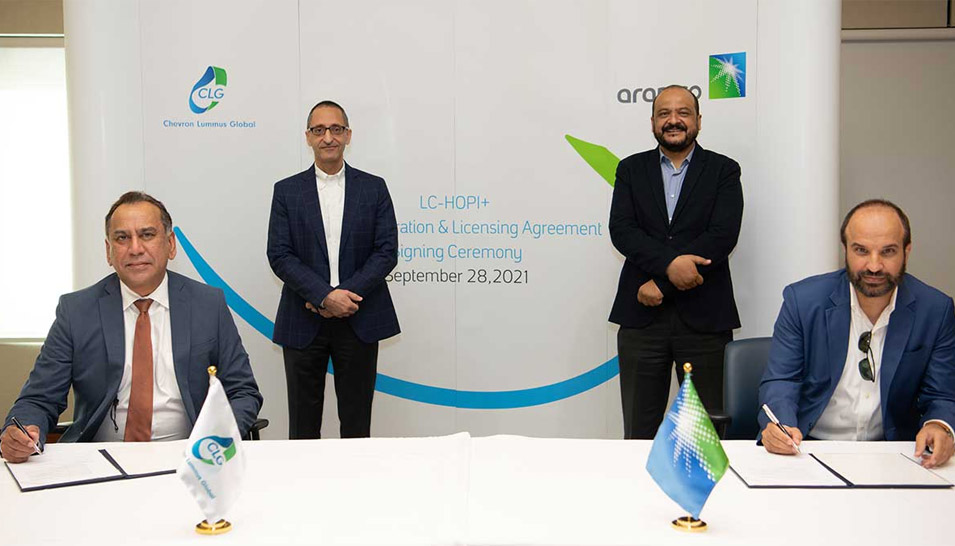Agreement will allow Chevron Lummus Global license Aramco’s Heavy Oil Processing Initiatives process and help maximize our crude revenues.

Aramco’s Motaz A. Mashouk, executive director of Engineering Services; Ahmad O. Al-Khowaiter, chief technology officer; and Abbas Al Ghamdi, CEO of Saudi Aramco Technologies Company ink a deal with Ujjal Mukherjee, managing director of CLG, that will help Aramco maximize crude revenues.
With their eyes on the future, Aramco, through its wholly owned subsidiary Saudi Aramco Technologies Company (SATC), recently signed a Joint Collaboration and Licensing Agreement (JCLA) with Chevron Lummus Global (CLG), a culmination of years of collaboration between CLG, one of the main licensors of the Ebullated Bed Hydrocracking technology worldwide, and Aramco.
The JCLA will allow CLG to license the Heavy Oil Processing Initiatives (HOPI+), an Aramco patented process technology that features an innovative configuration concept that aggregates crude oil processing with a solvent to remove asphalt. The technology’s value proposition is to improve hydrocarbon residue refining margins by yielding higher crude conversion rates, more stable operations, improved reliability, and increased energy efficiency.
Aramco can also maximize its crude revenues with the option to place its crude with licensors of the technology — potentially monetizing an additional 10% to 25% of additional crude. In addition, when the technology is licensed to a third party, Aramco will receive licensing fees.
Motaz A. Al Mashouk, Aramco’s Engineering Services executive director said, “This joint collaboration with CLG reflects the focus of Aramco on breakthrough technologies that generate added value across the hydrocarbon chain.”
“CLG and Aramco’s technology partnership will provide a strong foundation for better efficiencies in heavy crude oil processing,” said Abbas Al Ghamdi, CEO of SATC.
Many Potentials
As the technology configuration lowers CAPEX, it has the potential to provide an opportunity to acquire economies of scale in upgrading heavy crude residue. It also has the potential to be used in other bottom-of-the-barrel projects.
It is estimated that globally, of the approximately 80 million barrels per day of crude oil produced, 11 million barrels, or about 13%, are classified as heavy crude oils.
Overall, the technology will have a positive impact on the oil and gas industry, allowing Aramco to showcase its thought leadership in the push toward more efficient uses of energy — for as energy demands grow, the need to be innovative and economical also increases
The negotiation was led by members of Aramco’s Technology Strategy and Planning, Process and Control Systems, and Crude Oil Sales and Marketing departments with support from IP Law and SATC.